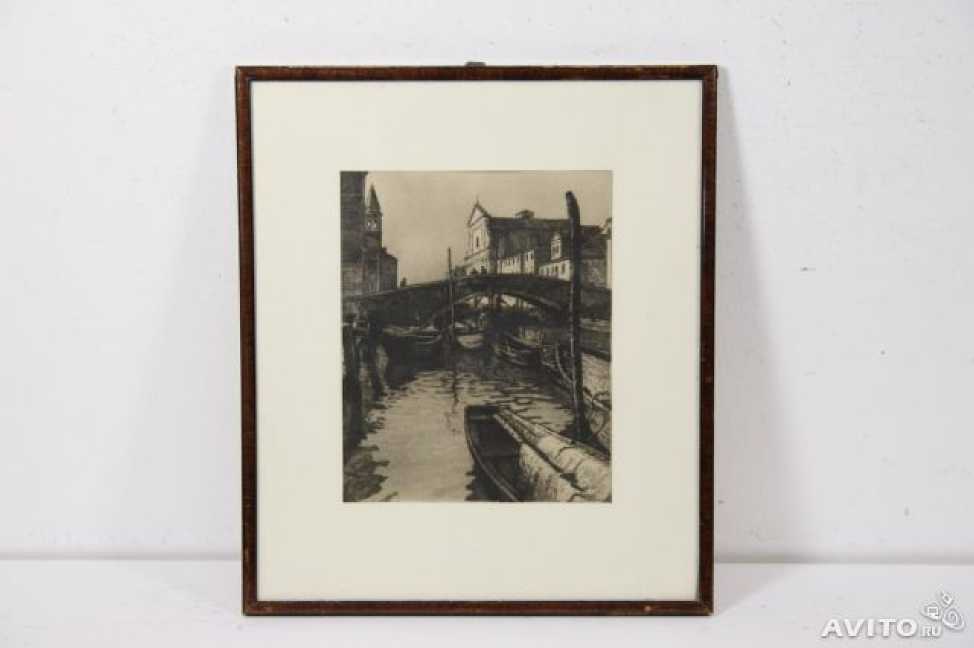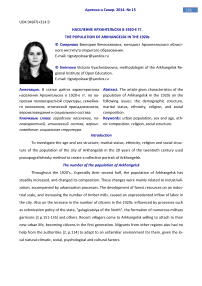The population of Arkhangelsk in the 1920s
Автор: Smirnova V.V.
Журнал: Arctic and North @arctic-and-north
Рубрика: Historical sciences
Статья в выпуске: 15, 2014 года.
Бесплатный доступ
The article gives characteristics of the population of Arkhangelsk in the 1920s on the following issues: the demographic structure, marital status, ethnicity, religion, and social composition.
Urban population, sex and age, ethnic composition, religion, social structure
Короткий адрес: https://sciup.org/148319852
IDR: 148319852 | УДК: 94(47)+314.9
Текст научной статьи The population of Arkhangelsk in the 1920s
To investigate the age and sex structure, marital status, ethnicity, religion and social struc--‐ ture of the population of the city of Arkhangelsk in the 20 years of the twentieth century used prosopografichesky method to create a collective portrait of Arkhangelsk.
The number of the population of Arkhangelsk
Throughout the 1920's., Especially their second half, the population of Arkhangelsk has steadily increased, and changed its composition. These changes were mainly related to industriali--‐ zation, accompanied by urbanization processes. The development of forest resources on an indus--‐ trial scale, and increasing the number of timber mills, caused an unprecedented inflow of labor in the city. Also on the increase in the number of citizens in the 1920s. influenced by processes such as colonization policy of the state, "gulagizatsiya of the North", the formation of numerous military garrisons [1 p.151--‐155] and others. Recent villagers come to Arkhangelsk willing to attach to their new urban life, becoming citizens in the first generation. Migrants from other regions also had no help from the authorities [2, p.114] to adapt to an unfamiliar environment for them, given the lo--‐ cal natural--‐climatic, social, psychological and cultural factors.
According to various archival data and data--‐Union Census 1926.1, Arkhangelsk the largest age category was 16--‐29 years young --‐ 35%, children under 15 accounted for 30% of the popula--‐ tion, the category of the population aged 30 to 59 years --‐ 31% of people aged 60 years and over --‐ 4%. A higher percentage of young people, compared with children, despite the high child mortality was due to the mobility of young people, which most other age groups came to Arkhangelsk from rural areas and other cities. In general, the city population was young enough that it is promising for its economic development.
Despite the recent revolution and war of the past, women in the city was more than men by only 3--‐4%2. This ratio was adjusted constantly arrive population in the city, among which a large proportion are men, otherwise the gap between female and male population would be much more significant.
Archangelsk were mostly family, without family was only about 3%3. After the entry into force of the new Family Code in 1927, began to grow the overall rate of marriages and divorces in the city 4, as the new Code also establishes civil (secular) registration of marriage and spouse enti--‐ tled to a divorce that not only simplifies the procedure of marriage and divorce, but also simplifies people's attitudes to marriage itself. Young people in a hurry to marry, knowing their right to a quick and easy divorce in case of failure. Divorce rate increased during this time from 2 ‰ to 14 ‰. On the 1928--‐1929 biennium. was the peak of divorce, for example, in 1928 the city was con--‐ cluded in 1157 and decorated 903 marriages divorce 5. Divorces were mainly due to the young age of the spouses, from 20 to 30 years old, married first marriage. Was the usual phenomenon of se--‐ cond, third marriages, second and third divorce.
The social composition of the population of the city in the 1920s. included: working --‐ which was 12% of the population, employees --‐ 13--‐17% of owners --‐ 3--‐4% of the unemployed --‐ 7.6%. About 50--‐60% of the population was non--‐active, mostly family members of the working popula--‐ tion: children, students, housewives and other women of this Category.
Ethnic and Religious composition of Arkhangelsk
The ethnic makeup of the city was quite variegated, but the vast majority of Arkhangelsk was Russian. Great was the proportion of Tatars, in 1926 they accounted for 1.5% of the popula--‐ tion (1145) and the proportion of the Jewish population --‐ 1.2% (896)6. It should be noted that the
Jewish population differed sufficiently high literacy. If among the Russian literate in 1926 was 69%, 55% among the Tatars, the Jewish population of 81%7. Also in the city lived Ukrainians, Poles, Lat--‐ vians, Zyrians and representatives of other nationalities. It was quite a lot of foreigners in the city, in December 1926, there were 105 people8. The most numerous were the Persians --‐ 53 people but they were Germans, Dutch, Finns, Norwegians and other foreign nationals. All of them were sub--‐ jected to mandatory registration and divided it by the following categories: a deserter, a prisoner of war, who had come on business, the concessionaire, journalist, employee, worker and peasant9. Most often, they come to visit, and, judging by the Russian surnames, among them were many immigrants who have taken foreign citizenship.
Russian population of the city is mainly professed Orthodoxy. All in all, Arkhangelsk in 1920. religious organization operated 21: 14 Orthodox, Catholic 1, 1 Protestant, Jewish 1, 1 Mo--‐ hammedan confession, 1 Old Believers, evangelists 1 and 2 of the newly formed group of believers of the religions10. Despite the difficult period for the Church and an active propaganda of atheism, the citizens maintained their religious beliefs, as evidenced by statistics committed by religious rites. More than 50% of births and deaths accompanied by religious rites11. Greater commitment to religious practices differed city center, while residents of his working--‐class suburbs often treat--‐ ed civil records.12. Determine now how much was really adherents of a religion, which was the percentage of believers and atheists among the citizens of that period, it is extremely difficult, since, in addition to members of officially registered religious organizations, there were many be--‐ lievers who were afraid to openly practice their religious beliefs .
Migration and Mobility
Throughout the 1920's. As already noted, in a very active character was of the mechanica movement of the population. Industry growth and the opening of new jobs attracted to Arkhan--‐ gelsk more people. For example, in 1926, arrived in the city 33,235 people, including 19,909 in the city and 13,326 in the timber, had lost 25,292, including 15,753 from the city, 9539 with timber mills 13. People came from other cities, but most of the rural areas. Dropped out of the city are also more likely in the countryside, along with seasonal workers returned to the village, those who could not get used to city life, or she does not live up to their hopes for a better life.
With the growth of the urban population and the increasing number of the migrants, spe--‐ cial settlers (and Arkhangelsk was flooded exiles) more and more cases of deviant behavior among the townspeople: drunkenness, crime, increase in the number of illegitimate children, prostitu--‐ tion, suicide. This was aided by the population lives in the extreme climatic conditions, combined with modernization and population explosion [3, p. 30].

Fig. 1.monument of Arkhangelsk early twentieth century. URL:
Conclusion
What was the population of Arkhangelsk in the 1920s. Applying prosopografic method for the characterization of the population, with all the above mentioned data, develops a collective portrait of Arkhangelsk 1920s. It turns out that he is, this arhangelogorodets, young enough, its average age is between 18 to 29 years; it belongs to the category of resident population, that is, he lives in the city or at birth, or with since arrived in Arkhangelsk in search of a better life. Though he is young, but has already managed to get a family that is predominantly married, though per--‐ haps fleeting. In this marriage he had no church, and registered in the registry office. This citizen workers employed in the timber industry or transport. He is Russian, who lives next door to the citizens of different nationalities, and he is orthodox, although officially not a member of any reli--‐ gious organization. And, despite the unbearable living conditions, hard work and the harsh cli--‐ mate, he enthusiastically looks to the future, grandiose plans and believes that they will be im--‐ plemented.
Список литературы The population of Arkhangelsk in the 1920s
- Northern Regional Studies in Contemporary regionology / Lukin Y. F. [et al.]. ‐ Arkhangelsk, "Graduate School of Business Administration IUPPK PSU. M. V. Lomonosov ", 2005. p.151-155..
- Korotaev V. I. On the verge of a demographic disaster: forced colonization and demographic crisis in the northern region in the 30s. XX century. - Arkhangelsk, 2004. p.114..
- Korotaev V. I. Russian North to. XIX - early XX century .: catching up modernization and social ecology. Author's abstract diss ... Doctor. hist. Sciences. - Arkhangelsk, 2000. P.30.


